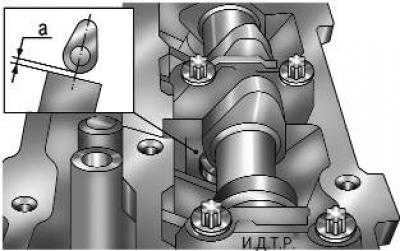Gap A (pic. 5.13) measured with a dipstick on a cold engine (at +20°C) between the camshaft cam (the cam must be pointing up from the pusher) and valve lifter. The nominal clearance for the intake valve is (0,17–0,23) mm, for graduation - (0,31–0,37) mm. The gaps are adjusted by selecting the thickness of the pushers. Spare parts are supplied with sets of pushers of different thicknesses.

Pic. 5.13. Measuring the gap in the valve drive: a - the measured gap
Regarding the timing belt, the valves located on the right are exhaust, on the left are intake.
You will need: all the tools needed to remove the camshafts (cm. «Replacing camshafts»), as well as a set of flat probes.
1. Set the piston of the 1st cylinder to the TDC position of the compression stroke (cm. «Setting the piston of the first cylinder to the TDC position of the compression stroke»).
2. Remove the cylinder head cover (cm. «Replacing the cylinder head cover gasket»).
3. Measure the gap a (see fig. 5.13) between the cams of both camshafts and the valve lifters. Record the measured clearances.
4. Turning the crankshaft by the bolt of its pulley each time by 180°, measure and record the clearances at the valves of the remaining cylinders. The order of operation of cylinders 1-3-4-2. It is necessary to replace the tappets of those valves whose clearances differ from the nominal values. After measuring all the gaps, set the piston of the 1st cylinder to the compression stroke position.
5. Remove the camshafts (cm. «Replacing camshafts»).
6. Remove the valve lifter that requires clearance adjustment from the cylinder head socket and record its thickness (it's listed on the back of it).
NOTE: The number stamped on the valve lifter is the tappet thickness. However, only three digits after the decimal point are shown (For example, «650» means pusher thickness 3.650 mm).
7. Calculate the thickness of the new pusher using the formula (all values in mm):
H = B+A–C, Where
A - measured clearance;
B - the thickness of the old pusher;
C - nominal clearance;
H - the thickness of the new pusher.
8. Install the new pusher in place.
9. Similarly replace pushers of all valves at which adjustment of a backlash is required.
10. Install the camshafts, but do not install the timing belt yet.
11. Turning the camshafts for the hexagons made on them, measure the resulting gaps with feelers. If the gaps are out of specification, repeat the adjustment (see paragraphs. 6–8).
12. If all backlashes correspond to nominal values, turn camshafts so that cams of a drive of valves of 1st cylinder were established, as is shown in fig. 5.13.
13. Install the timing belt and all removed parts in the reverse order of removal.
Visitor comments